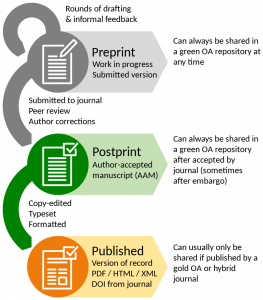Preprints, Preprint servers and Overlay journals
Ginny Barbour; Stephanie Jacobs; and Catherine Radbourne
A preprint is a version of a paper that has not yet been submitted to a peer-reviewed scientific journal, but which is publicly available. Physics and mathematics had a long tradition of preprints even before the internet, through the sharing of paper copies. However, most preprints are now shared online though specialist, open access sites, known as preprint servers. Overlay journals are an emerging type of journal which facilitate the sharing and peer review of preprints.
Getting Started
Preprints & PREPRINT SERVERS
The best known and one of the earliest global online preprint servers was arXiv which publishes papers in physics, mathematics and related disciplines. The number of preprint servers has been increasing in the past few years and they are now almost ubiquitous globally and across disciplines. They may be specific for a particular country (eg RINarxiv for Indonesia) or discipline specific (eg SocArXiv for the Social Sciences). Two of the biggest preprint servers are run by Cold Spring Harbor Press: bioRxiv for the biological sciences and medRxiv for the health sciences. The Open Science Framework (OSF) also hosts a large number of preprint servers.
Preprint servers became a crucial way for the rapid dissemination of preprints in the pandemic and gained enormous readership. medRxiv and bioRxiv have together published more than 17,000 preprints on the pandemic (data from July 2021), with a readership peaking at 10 million abstract views per month in April 2020. The place of preprints is still being debated in some disciplines. Until quite recently many journals would not accept submission of a paper that had been previously shared as a preprint. This attitude is changing rapidly and some preprint servers and journals collaborate directly to facilitate the direct submission of a preprint from a preprint server to a journal. You can view specific a journal’s preprint policies via Sherpa Romeo.
Virtually all preprints are fully open access – which means they are immediately and freely available, and can be used for any purpose specified by the open license they are published under (usually a Creative Commons license). Preprints on reputable servers will have a DOI, which ensures that the preprints can be found and indexed through both search engines such as Google Scholar and via specific databases such as Europe PMC.
There are a number of benefits for preprints as a method of research dissemination. Preprints reduce the amount of time it takes for a publication to be seen, which is especially important in emergencies. A number of funders are recognising the importance of preprints: the Wellcome Trust requires the posting of preprints “where there is a significant public health benefit to preprints being shared widely and rapidly, such as a disease outbreak”
Posting a preprint can also potentially benefit researchers directly. They can allow researchers to establish precedent, and get credit for their work while peer review is occurring – which can take many months to complete. Posting a preprint is also associated with a higher level of citations to the final published version. However, not all preprint articles are finally published in a journal.

Preprints are just one version of an article. A postprint (now more usually known as the accepted version or author accepted manuscript) is an article that has been peer reviewed in preparation for publication in a journal and will often be different in content from a preprint. It is therefore important that versions of an article are clearly marked. Preprint servers make it clear that the preprints posted are version of articles that have not yet been through the formal process of peer review. The image to the left shows the relationship of versions of articles to each other (preprint, postprint, and published) with how each of these versions can be shared in an open access way.
ASAPbio is the definitive source of information on preprints, and includes an extensive set of FAQ and other resources. Much has been written both in praise of preprints eg (Fry et al., 2019) and expressing skepticism. (Sheldon, 2018) However, preprints are definitely here to stay and it is important therefore to be educated about their benefits and limitations.

Exercise: Read: In praise of preprints and Preprints could promote confusion and distortion

Consider:
Learn More
Overlay Journal
An overlay journal is a new type of open access academic journal. Unlike traditional journals, an overlay journal does not produce its own content. Rather, the editors assess candidate articles retrieved from the pool of open access content available on preprint servers, repositories and other public domain sources. Articles selected for inclusion in the journal are then published in a journal issue. Some overlay journals use the same editors for all issues whereas others may use an editor (or group of editors) with specific expertise for themed issues. An early example of an overlay journal is Discrete Analysis, which selects papers from arXiv.

Texts chosen for publication into an overlay journal may be publicly validated in a number of ways. These could be:
- The editor/s may republish the article with explicit approval, which may be additional text or metadata;
- The editor/s may provide a link to the article via the overlay journal’s table of contents; or,
- The journal may simply provide links to articles that have already been published in an open access journal.
Should the link be to an article that is already published, value is added by curating a collection of scattered articles into a single issue that covers a particular theme. These themed issues are useful for focused coverage of emerging or niche topics.
In 2019, JMIR Publications, an open access publisher, announced the creation of a series of “superjournals”, named JMIRx (JMIRx.org), which are overlay journals for preprint servers such as medRxiv, bioRxiv and PsyArXiv [3]
Episciences.org is an overlay journal platform, hosting journals on all scientific subjects. Their editorial boards organise peer review and discussion of submitted or selected preprints which attaches scientific caution to these papers.
 Exercise: Search for available overlay journals that match to your faculty. How many are there? Are any superjournals included?
Exercise: Search for available overlay journals that match to your faculty. How many are there? Are any superjournals included?
Challenge me
Matching exercise: Use the infographics on Preprint FAQ – ASAPbio to find the answers to these questions.
- Boost the reach of your science
- Preprints increase the visibility of your work!
- Preprint fact checking
- Preprints in the life sciences by numbers
Attribution
Content in this chapter has been developed by QUT Library, including content derived from:
- Preprint and Overlay journal via Wikipedia, distributed under a Creative Commons Attribution-ShareAlike License.
- ASAPbio – Preprint FAQ Infographics by ASAPbio Fellows: Ana Dorrego-Rivas, Carrie Iwema and Mafalda Pimentel Preprint FAQ – ASAPbio
- Fry, N. K., Marshall, H., & Mellins-Cohen, T. (2019). In praise of preprints. Microbial genomics, 5(4), e000259. https://doi.org/10.1099/mgen.0.000259.
- Sheldon T. (2018) Preprints could promote confusion and distortion. Nature. Jul;559(7715):445. doi: 10.1038/d41586-018-05789-4. PMID: 30042547.
All information correct at time of publication 9 August 2021.
Image Credits
Royalty-free images used on this page were sourced from unsplash.com.
Icons created by priyanka and Wichai Wi from Noun Project.
Publishing workflow image is by Thomas Shafee, adapted from diagram by Ginny Barbour and is available under CC-BY 4.0 license.

